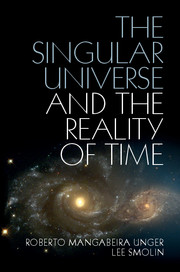Book contents
- Frontmatter
- Contents
- The nature and scope of this work
- Part I Roberto Mangabeira Unger
- Part II Lee Smolin
- 1 Cosmology in crisis
- 2 Principles for a cosmological theory
- 3 The setting: the puzzles of contemporary cosmology
- 4 Hypotheses for a new cosmology
- 5 Mathematics
- 6 Approaches to solving the meta-law dilemma
- 7 Implications of temporal naturalism for the philosophy of mind
- 8 An agenda for science
- 9 Concluding remarks
- Acknowledgments
- References
- A note concerning disagreements between our views
- Index
6 - Approaches to solving the meta-law dilemma
Published online by Cambridge University Press: 05 December 2014
- Frontmatter
- Contents
- The nature and scope of this work
- Part I Roberto Mangabeira Unger
- Part II Lee Smolin
- 1 Cosmology in crisis
- 2 Principles for a cosmological theory
- 3 The setting: the puzzles of contemporary cosmology
- 4 Hypotheses for a new cosmology
- 5 Mathematics
- 6 Approaches to solving the meta-law dilemma
- 7 Implications of temporal naturalism for the philosophy of mind
- 8 An agenda for science
- 9 Concluding remarks
- Acknowledgments
- References
- A note concerning disagreements between our views
- Index
Summary
The principles and hypotheses we present in this book become a research program when we see that they can be implemented in particular theories and models. As we have argued, such a theory must be based on the idea that the laws of nature evolve in a real, global, cosmological time. These must avoid the cosmological dilemma and fallacy and so cannot be expressed within the Newtonian paradigm, yet they have the task of providing sufficient reason for the laws and initial conditions that govern subsystems of the universe. We can call the problem of framing this new paradigm of explanation the meta-law problem, because the issue is to discover how and why laws evolve. This must be done in a way that avoids the meta-law dilemma.
It is natural to describe the evolution of laws by means of an imagined space of possible laws. The evolution of laws can then be visualized and studied as evolution of either an individual universe or a population of universes on this space of possible laws. In the first case, for example, we have a sequence of points representing the laws that hold in different eras of a universe. The space of possible laws has come to be called the landscape; this terminology was first introduced in the context of cosmological natural selection and was chosen to evoke thoughts of the fitness landscapes that are studied in models of population biology [8]. In some, but not all, work on the landscape, it is assumed that the possible laws represented by points of the landscape are perturbative string theories, each an expansion around a vacuum state of string theory, which is in turn a solution to a meta-theory such as M theory. In these cases we refer to the landscape of string theory.
- Type
- Chapter
- Information
- The Singular Universe and the Reality of TimeA Proposal in Natural Philosophy, pp. 447 - 479Publisher: Cambridge University PressPrint publication year: 2014

